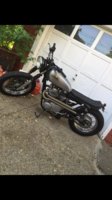I'm not sure what cap/green wire you're referring to... Are you talking about the left control housing? Take some pics to help us see what you're looking at.
Speaking of pics, here's a few pics of the stater motor and starter relay to make sure we're talking about the same thing. This is off of a '79 special, but I don't think the starter components varied all that much (not sure what year your bike is)
Starter Relay:
From this angle, it's the square box/thing with two Black boots covering the two thick black wires. You can also see a blue/white wire and a red/white wire running to it.
The two big black wires are essentially "positive" wires. One goes to your positive terminal on your battery (Left boot/wire in the pic). The other goes directly to your starter motor (Right boot/wire pic).
The Blue/white is the ground coming from your starter button. The red/white is power and comes from your starter kill switch.
Here's a pic of a starter motor:
Your starter motor doesn't have a ground wire...it's grounded to the frame by the 4 bolts holding it in. The one wire you see is the one that goes to the relay in the above pic. As you can see the wire is black...and it has another boot covering the terminal bolts.
Here's the starter as it sits under your engine:
You can just make out the boot covering the positive wire.
Do you have a multimeter? If so, lets do some basic things first (If not, you can still test with a simple 12v test light and you'll need to connect one end to the positive on your battery, while you probe the handlebars, etc):
1) check that your handlebars are grounded. (On my multimeter it beeps when there's continuity...yours may also?) I'm guessing the bars are grounded, since you said it worked before, right? But perhaps the battery fried something or shorted out a wire? Better to rule out anything as it's really simple to check.
If they are grounded, then chances are the button is also grounding as it's suppose to... but let's test it. Go to that relay (like in the pic)... with the starter button pressed, the blue soldered connection should now be grounded, and your multimeter will detect continuity (Or with a test light, connect one end to the positive of the battery and touch the other end to the soldered blue/white wire connection at the relay...the light should come on). If it's grounding, meaning you have continuity/or test light comes on, then you should do the same continuity test but for the positives.
2) So key on, starter kill switch on (as if you're starting the bike)...you should now have power to the red/white wire on the relay. You can test this with your multimeter (positive batter connection to red/white soldered connection on the relay). Or with a test light, touch the soldered red/white wire at the relay and touch any part of the bike that's grounded (from/bolt, etc)...the light should come on.
If either of these tests don't work, then you have an issue at the starter switch (button or kill switch...whichever didn't work...and if it's the kill switch, we'll need to trace it to the fuses, etc.) If they did work, then you know your starter button/switch are good. What's still suspect is the relay, and the starter motor. There are several ways we can test these...and I'll go through a few, to keep it short.

What should happen with the relay is when the key is on, kill switch is on (like you're going to start the bike) and you press the starter button, your relay should make a "click" sound as it activates and sends direct positive current (From the left boot/wire which comes straight from your battery) to the wire going to the starter motor (Right boot/wire).
3) Test for continuity for left boot & right boot at the relay. Simply touch the positive battery terminal and the left boot (Pull the boot off)--It should be positive all the time as it's essentially an extension of the positive terminal; For the right boot, key on, kill switch on, and press the starter button-- at the same time--touch the right boot/wire (pull boot off). So to recap, the right boot/wire should have power when the starter button is pressed. If it doesn't...then your relay is bad. And we know this because we already determined that the starter button is sending a ground to the relay, and the kill switch is sending power when the key is on, and the kill switch is on.
If you have power at the relay via the above test, then we need to test your starter motor.
3) The quickest way (PUT BIKE IN NEUTRAL) is to take a jumper wire from the positive terminal on the battery, and connect the other end to a screwdriver --pull back the boot at the starter motor (under the bike) and touch it (Probably get a few sparks fyi) but if the starter motor spins, your motor is fine. If it doesn't spin, your starter has an issue.
Another way without crawling under the bike is to simply jump the left boot/wire and the right boot/wire at the relay (You can just use a screwdriver and touch both terminals on the relay...same thing, the motor will either spin or not.
OK, hopefully this made some sense?




